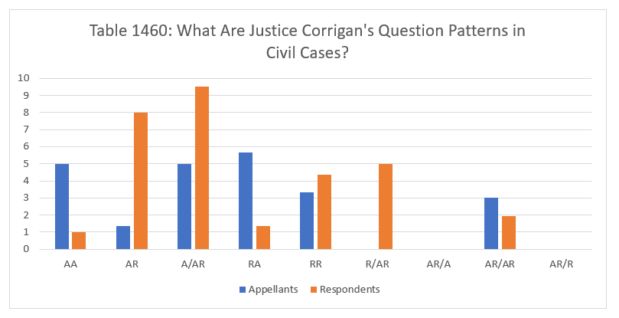For the last two weeks, we've been looking at the Supreme Court's question patterns at a court-wide level. We reviewed the academic literature studying oral argument questions at the U.S. Supreme Court, which has concluded that the party which will lose averages the most questions. We then reviewed the year-by-year data at the California Supreme Court to look for similar patterns.
Now, we're beginning to review the data one Justice at a time. Does each individual Justice match the usual pattern - more questions to the loser - when he or she agrees with the majority? What about when she or he doesn't agree with the majority - does she more heavily question the party which will lose the case, or the party she thinks should lose the case? We divide the case data by every possible combination of court result and a Justice's vote - affirmances, reversals and split decisions ("affirmed in part, reversed in part").
We begin, in light of Justice Chin's recent retirement, with Justice Corrigan's record in civil cases. When Justice Corrigan joins the majority in an affirmance, she clearly questions appellants more heavily 4.98 to 0.98 for respondents. When the majority affirms but Justice Corrigan wants to reverse, she more heavily questions the respondent - 8 questions for respondents and an average of only 1.33 for appellants. When the court affirms but Justice Corrigan wants a split decision, she averages 9.5 questions to respondents and 5 to appellants.
When Justice Corrigan joins the majority in a reversal, she more heavily questions the losing respondent, although the gap between loser and winner is much less than for affirmances: 4.38 questions for respondents, 3.31 to appellants. When Justice Corrigan wants to affirm but the majority reverses, she concentrates on appellants: 5.67 questions to appellants, 1.33 to respondents. Although there have been few reversals where Justice Corrigan supported a split decision, she concentrates on respondents: 5.0 to respondents, 0 to appellants. Finally, where Justice Corrigan joins the majority in a split decision, she concentrates on the appellant: 3 questions to appellants, 1.93 to respondents.

Join us back here tomorrow as we review Justice Corrigan's data in criminal cases.
Image courtesy of Flickr by FancyLady (no changes).
Originally published by California Supreme Court Review on the 31st of October, 2020
The content of this article is intended to provide a general guide to the subject matter. Specialist advice should be sought about your specific circumstances.

